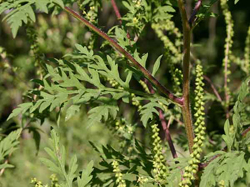
Allergies and Hayfever
What is hay fever?

35 million Americans suffer from hay fever, or Seasonal Allergic Rhinitis. Hay fever is an allergic reaction that can cause:
- Sneezing
- Runny nose
- Coughing
- Itchy eyes
- Asthma attacks
People who have hay fever are allergic to specific plant pollens in the air, including those from trees, grass or weeds. However, other sources such as mold spores, dust, household mites, tobacco smoke, perfumes, smog and animal dander can cause allergies with similar symptoms.
What is a hay fever plant?
Hay fever plants are most often pollen-producing male plants that rely on wind to transport their pollen. Female plants, which have large, brightly colored fl owers and produce seed pods, berries and fruit, usually do not bother hay fever sufferers.
People often like to plant male plants instead of “messy” female plants, which makes it hard for those with allergies. This has led to an increase in pollen counts over the years.
Because winds can carry the light-weight pollens over long distances, people with allergies may never see the plants that cause their symptoms!
While there are not that many kinds of hay fever plants, some of them, such as grasses, occur in very large numbers.
In the U.S., approximately 14 million doctor visits are made each year because of hay fever symptoms.
Approximately 80% of school age children with asthma also have allergies.
Sources: (1) Centers for Disease Control and Prevention; (2) Breysee et al. “The relationship between housing and health: Children at risk” Environmental Health Perspectives 2004; 112: 1583-1588
How can I control hay fever?
Knowing when there will be high pollen levels can help you prevent hay fever symptoms. When this happens:
- Limit your outdoor activity
- Keep your windows closed
- Take medicines before you are around pollen to reduce the effect
You can get information about pollen levels in your area through:
- Local weather reports
- National Allergy Bureau (NAB) of the American Academy of Allergy and Immunology
- www.allergyescape.com
- www.pollen.com
Avoiding pollen all of the time may be impossible. Pollen can be anywhere, so moving to another area to avoid your allergies will probably not help. Here are some other tips to control your hay fever:
- Find and get rid of any problem plants.
- If you cannot remove problem plants, prune them back regularly.
- Avoid planting high-pollen plants near windows or doors.
- Avoid planting male (pollen-producing) plants.
- Use allergy medicine (like antihistamines or nasal sprays) before you begin gardening rather than after you get symptoms.
- When working outdoors, wear glasses, a face mask, hat, gloves and long-sleeved shirt to reduce your contact with pollen.
- Garden on cool or cloudy days and in the late afternoon and evening when pollen levels tend to be lower.
- Don’t dry your bedding outdoors when pollen counts are high, since pollen clings to fabric.
- Wash pets often as they can carry pollen into the house.
- Have someone else mow lawns and weed flowerbeds.
- Avoid touching your face and eyes while working outdoors.
- Rinse your nose with salt-water (saline) when pollen counts are high.
- To cut down on allergens: shower, wash your hair and change your clothes when you have finished working outdoors.
Allergies affect as many as 50 million Americans and is a leading cause of illness and disability in the United States.
Approximately 35 million Americans suffer from allergic reactions to airborne allergens such as pollen
Source: 2003 Dept Health and Human Services
Want to Learn More?
If you would like us to send you a brochure which lists common hay fever plants in California by their pollen season, please contact your local office.
You can also check out these hay fever resources:
- American Academy of Allergy, Asthma and Immunology
- Asthma and Allergy Foundation of America
- Allergy Escape